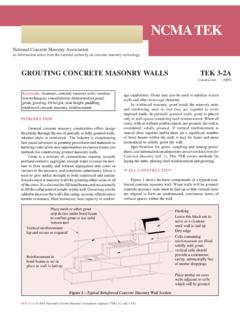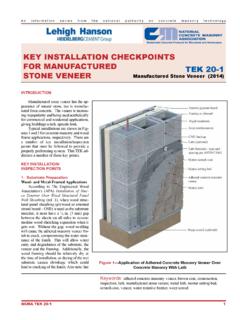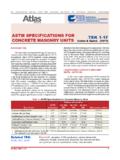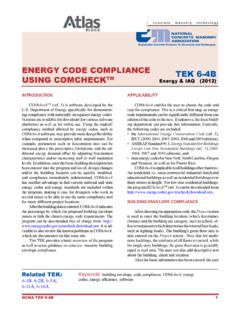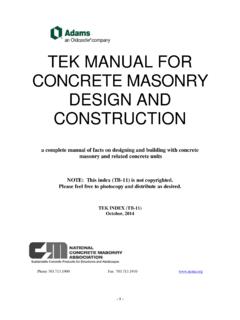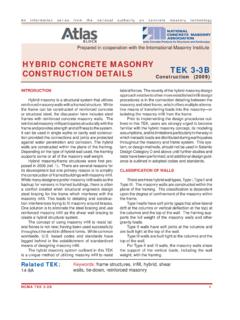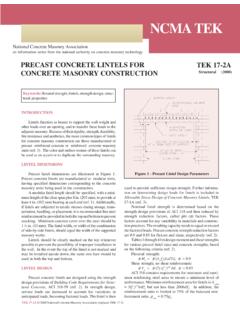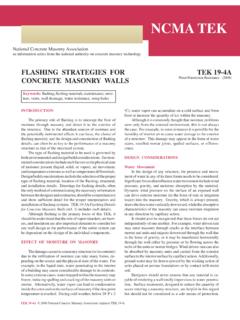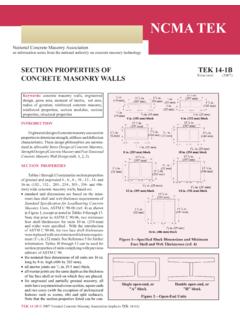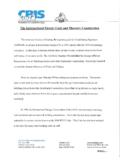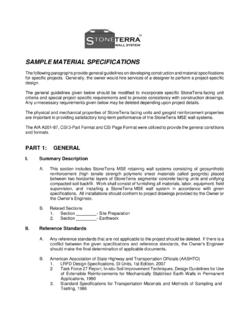Transcription of NCMA TEK
1 ncma TEK. National concrete masonry Association an information series from the national authority on concrete masonry technology CRACK CONTROL FOR concrete BRICK AND TEK 10-4. Movement Control (2001). OTHER concrete masonry VENEERS. brick units or half-high concrete masonry units, as shown Keywords: concrete brick, control joints, crack control, joint reinforcement, shrinkage, veneer in Figure 1. concrete brick units most commonly have a nominal thickness of 4 in. (102 mm), lengths of 8, 10, 12 or 16 in. (203, 254, 305 or 406 mm) and heights from 2 1/2 to 6 in. INTRODUCTION (64 to 152 mm). The specified size of a concrete brick is typically 3 5/ 8 x 2 1/4 x 7 5/ 8 in. (92 x 57 x 194 mm). They are concrete masonry veneer is used to provide a beautiful, usually laid with bed joints slightly larger than the standard 3. economical and highly durable exterior. concrete brick are /8 in. (10 mm) thickness to provide a constructed height of widely used over concrete masonry , concrete frame, steel 2 2/3 in.
2 (68 mm), so that three courses of concrete brick or wood structural backup. concrete brick masonry also equals one 8 in. (203 mm) high module. In many cases, offers tremendous architectural versatility. The finished additional sizes and configurations are available. Consult appearance of the wall can be altered by changing the unit local manufacturers for available sizes, colors and surfaces. size, unit or mortar color, as well as the masonry bond This TEK addresses crack control measures specifically pattern. A wide range of surface textures is also available, developed for concrete masonry veneers to accommodate such as split face, molded, striated, or "wormed," which cracking resulting from internal volume change of the describes a series of random, twisted indentations. In concrete masonry . Potential cracking resulting from addition, concrete brick can be used to provide a traditional externally applied loads is not covered. Further information clay brick appearance, while offering the flexibility avail- on concrete masonry veneers is available in TEK 3-6A.
3 Able with the colors and architectural finishes of conven- concrete masonry Veneers, TEK 16-2A concrete Brick tional concrete masonry products. Tumbled concrete brick Structural Design Considerations and TEK 16-3A Structural and surface color coatings are also available to simulate the Backup Systems for masonry Veneer (refs. 3, 4 and 5). look of antique brick. The term "brick" historically refers a masonry unit that concrete BRICK COMPARED TO CLAY BRICK. can be held in the hand, although the term is often associ- ated with fired clay masonry . concrete masonry veneers Building with concrete brick has some intrinsic differences that resemble brick are constructed using either concrete from building with clay brick due to different material proper- ties. One should not be substituted for the other without due consideration of these differences. concrete masonry walls have an overall tendency to shrink, whereas clay brick walls tend to expand. Both concrete and clay masonry may use movement joints to accommodate this movement, although the type of joint is different for clay than for concrete masonry .
4 When control joints are required, concrete brick requires only vertical control joints whereas clay brick typically requires both vertical and horizontal expansion joints to accommodate panel expansion. In commercial con- struction, horizontal expansion joints are most often installed at each floor level below steel shelf angles used to support the clay brick. concrete brick installations may include shelf angles as lintels over openings or in curtain wall construction. Placing concrete brick units also differs from placing clay brick. Because the production techniques differ between con- crete and clay brick, concrete brick have very consistent dimensional tolerances compared to clay brick. concrete brick TEK 10-4 2001 National concrete masonry Association 3 5/8 in. Unit Characteristics (92 mm) Conventional concrete masonry crack control recom- 5 3 5/8 in. mendations, such as those presented in TEK 10-2B, 3 /8 in. (92 mm). (92 mm) Control Joints for concrete masonry Walls Em- 2 1/4 in.
5 Pirical Method (ref. 1), have been developed based (57 mm) primarily on the performance of walls constructed n. using larger hollow concrete masonry units, such as n. 5 /8 i 5 / 8 i m) 5 m m) the common 8 x 8 x 16 in. (203 x 203 x 406 mm). 7 94 m 1 7. (1 (39 Because the units used for veneers are often pro- duced specifically for veneer applications, the physi- 100% Solid Half-high cal properties may differ from those of larger concrete Figure 1 Common Brick-Sized Units (actual dimensions shown) masonry units. These differences can impact how the concrete masonry veneer moves and reacts to should not be wetted prior to placement. concrete brick unit changes in moisture content and temperature. Hence, crack properties are summarized in TEK 1-1C, ASTM Specifications control recommendations have been tailored specifically for for concrete masonry Units (ref. 7). concrete masonry veneers. When clay brick banding is incorporated in a concrete Ensuring that the concrete masonry units are relatively masonry veneer, a horizontal slip plane is used to accommodate dry when laid and remain dry during construction will also help differential movement between the two materials.
6 See TEK 10- minimize initial drying shrinkage of the wall. 1A, Crack Control in concrete masonry Walls (ref. 11) for Techniques to minimize water absorption by the veneer more information. will also help limit subsequent movement due to moisture loss. Some manufacturers have had success in reducing veneer CRACK CONTROL RECOMMENDATIONS movement by incorporating integral water repellents in the veneer units during manufacture. When used in the units and concrete masonry veneer units, like all concrete products, added to the mortar on site, integral water repellents help tend to decrease in volume as drying occurs. This potential minimize water absorption. See TEK 19-1 Water Repellents for shrinkage should be provided for in the design, detailing and concrete masonry Walls (ref. 2) for additional information on construction to minimize shrinkage cracking. Shrinkage cracks integral water repellents. in concrete masonry are an aesthetic, rather than structural, concern. Because veneers, by definition, are primarily aes- Mortar thetic, crack control for veneers is often a high design priority.
7 Using a lower compressive strength mortar helps ensure While movement due to moisture change is the primary that when cracks do occur, they occur in the mortar joint rather focus when addressing nonstructural movement in masonry than through the unit. Type N mortar is often specified for walls, temperature changes can also cause reversible shrink- concrete brick veneers, because it tends to be more flexible than age and expansion. It should be noted that darker masonry other mortar Types. ASTM C 270, Standard Specification for units as well as those installed on southern and western Mortar for Unit masonry (ref. 6) recommends Type O mortar exposures will experience larger daily temperature variations for exterior above grade nonloadbearing walls where the ma- due to solar exposure, and hence may require more attention sonry is unlikely to be frozen when saturated, or unlikely to be to adequately address wall movement. subjected to high winds or other significant lateral loads.
8 C 270. Crack control measures for concrete masonry veneers are recommends that Type N or S mortar be used in other cases. similar to those for other concrete masonry walls. In fact, conventional concrete masonry crack control measures, such Joint Reinforcement as those in TEK 10-2B, Control Joints for concrete masonry Horizontal joint reinforcement effectively limits crack width Walls Empirical Method (ref. 1), have been used success- by holding any cracks that form tightly together. For this fully for concrete masonry veneers in many cases. reason, joint reinforcement, spaced at 16 in. (406 mm) on center, Crack control recommendations for concrete masonry is recommended in concrete masonry veneers, although ac- veneers are summarized below and are described more fully in ceptable performance has been achieved without joint rein- the following sections. forcement in some cases. To protect joint reinforcement from corrosion, Specifica- Crack Control Recommendations for tion for masonry Structures (ref.)
9 9), requires at least 5/8 in. (16. concrete masonry Veneersa mm) of mortar cover between the joint reinforcement and the . Control joints: maximum panel length to height ratio of 1 1/2, weather-exposed face of the masonry . and maximum spacing of 20 ft ( m) and where stress When both joint reinforcement and control joints are used, concentrations occur the joint reinforcement should be discontinued at the control . Joint reinforcement: at 16 in. (406 mm) joint to avoid restricting horizontal movement at the joint.. Mortar: Type N. Control Joints a Adjust as needed to suit local conditions and experience. Control joints are vertical separations built into the veneer and located where stress concentrations are likely to cause criteria and spacing requirements, see TEK 12-1A, Anchors cracks. The joints allow unrestrained longitudinal movement, and Ties for masonry (ref. 8)). Ties should be placed within 12. thereby relieving horizontal tensile stress that may develop due in. (305 mm) of the control joint.
10 When flexible ties are used, to shrinkage. control joint locations need not align with control joints in the Ideally, a control joint should be located wherever masonry backup when a masonry backup wythe is used, although it is volume changes are likely to cause cracking. Because this can considered good practice to align them. If the veneer is rigidly be difficult to determine in practice, the following are general bonded to a masonry backup, however, control joints should guidelines for locating control joints. extend through the backup and veneer in the same location. For veneer panels without openings or other points of stress concentration, control joints are used to effectively Residential Construction divide a wall into a series of panels. In general, it is desirable to Control joint recommendations for larger buildings typi- keep these panels as square as possible to minimize cracking cally call for a control joint at each window, and on both sides between the control joints.
